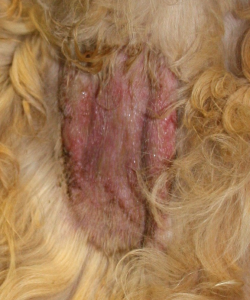Hotspots are patches of very inflamed, painful and moist skin. They can develop very rapidly as a result of intense scratching. As the inflamed skin oozes, the surrounding hair sticks tight over the area, creating an ideal environment for bacteria to grow and creating a foul odour. But hotspots aren’t caused by that stinky bacteria— they’re typically a result of allergy or anything else that causes your dog to scratch intensely at one location e.g. insect bites (flea/mosquito, etc), heavy dense coats, matts, etc.
Hotspots are not pustules
Hotspots are different to pustules. Pustules are smaller, less painful, less smelly and less obvious than hotspots. In most cases, pustules are caused by bacterial infection in or on the skin. Pustules typically start very small and are difficult to see. When pustules break, the bacteria and debris spill out. As this material dries, it forms a crust that traps the surrounding hairs and irritates the skin, causing a roughly circular ring of redness called a collerette. When the crust falls off, it takes the hair with it, leaving a small, but obvious, hairless area. Pustules often result in itching but are rarely painful.
Treatment of hotspots
Hotspots must be cleaned gently with an antiseptic in the veterinary hospital. The hair surrounding the hotspot usually needs to be shaved to prevent it from covering the wound and becoming matted with discharge. The pain can be so bad that your dog may need be sedated prior to cleaning. Often the inflamed area is larger than what is initially obvious.
After cleaning we will typically prescribe an oral antibiotic. Oral pain relievers and anti-inflammatory drugs might be given as well depending on your pet’s medical history. We will usually give you a medicated wash for bathing and sometimes an emollient cream to continue to keep the area clean. E-Collars may be necessary to prevent your pet bothering the infected area, as saliva makes hotspots worse.
A follow-up exam which we will schedule for you is an important part of the treatment plan. During this visit, your veterinarian will determine whether the infection has resolved or if new hotspots and pustules are popping up. If your dog’s pain and discomfort is under control, this visit might be the perfect time to investigate the underlying cause of the hotspot or pustules.
Outlook
Whether pustules or hotspots are affecting your dog, we should investigate the cause to reduce the chance they’ll pop up again. Allergic dermatitis is the most common underlying cause of both pustules and hotspots.
You should see a reduction in itching and discomfort. If there was a foul odour, it shouldn’t return. If new spots develop, you should call your veterinarian immediately. Some pets may get one or two hotspots and never get one again, while some pets have frequent reoccurrences.




